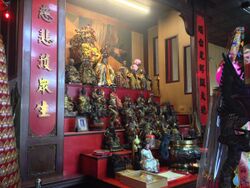Religion:Baishe Niangniang
| Baishe Niangniang |
|---|
Baishe Niangniang (Chinese: 白蛇娘娘), formerly known as Bai Suzhen (Chinese: 白素贞), is a goddess in Chinese folk religion.[1] Before becoming a deity, she was a thousand-year-old white snake spirit who received the essences of the sun and moon.[2]
Bai Suzhen is the main character of the "Legend of the White Snake", one of China's four greatest folk tales. It has been adapted many times, including into Chinese operas, films, television series and other media.[3][4]
Legend
After one thousand years of disciplined training in Taoism on Mount Emei, the white snake, Bai Suzhen, is transformed into a woman by the essence of the Dragon King of the East China Sea. She decides to go out into the human world and do good deeds in order to become immortal. She is later accepted by the goddess Lishan Laomu as a disciple.[2][5]
On a visit to West Lake, she falls in love with a young man named Xu Xian and soon becomes his wife. Eventually, however, a Buddhist monk, Abbot Fahai, discovers her true origin and compels her to fight for both her marriage and her freedom. At last he tracks down the couple, defeats Bai Suzhen and imprisons her in the imposing Leifeng Pagoda. She is finally freed from the pagoda when her son's filial piety moves Heaven.[2]
In some versions, after her imprisonment she is transformed into the goddess Yaotai Laomu's mount. She goes on to accompany Yaotai Laomu for many years as they attempt to help all living beings and save the world.[6]
Worship
Bai Suzhen is worshipped as a deity in Chinese folk religion, where she is also known as Baishe Niangniang.[7] It is said that she and Xu Xian once practiced Chinese medicine and that believers came to them seeking healing and health advice. In Taoyuan City, Yangmei District, Taiwan, the White Snake Temple (zh) was built in 1991 and dedicated to her.[8][9]The temple inaugurated the annual Dragon Boat Festival to celebrate the birthday of Baishe Niangniang, and it has become a traditional and popular event.[10][11]
Influence
Gallery
References
- ↑ "杨梅白蛇庙 全台唯一供奉白娘子 - 生活" (in zh). 中时新闻网. 1 June 2014. https://www.chinatimes.com/cn/realtimenews/20140601002397-260405?chdtv.
- ↑ 2.0 2.1 2.2 "9 Powerful Snakes from History and Mythology". The History Channel. https://www.history.com/news/snake-symbol-history-mythology.
- ↑ "This Old tale still resonates today to a modern audience". China Daily. 10 April 2019. https://global.chinadaily.com.cn/a/201904/10/WS5cad3138a3104842260b549c.html.
- ↑ "'The Legend of White Snake' is distributed in North America, Western Europe and widely across Oceania." (in en). SHINE. 4 April 2019. https://www.shine.cn/feature/entertainment/1904042485/.
- ↑ "'The Legend of the White Snake, Chinese Mélusine Story'". 5 November 2017. https://www.medievalists.net/2017/11/legend-white-snake-chinese-melusine-story/.
- ↑ "桃園白蛇廟 白蛇佑眾生 - 焦點" (in zh). 自由時報電子報. 13 February 2013. https://news.ltn.com.tw/news/focus/paper/654135.
- ↑ "全台唯一白蛇廟 小龍年到香火盛│TVBS新聞網" (in zh). TVBS. 26 January 2013. https://news.tvbs.com.tw/other/3664.
- ↑ "直播:白蛇庙供白娘子养白蛇,300条!_ING现场-梨视频官网-Pear Video" (in zh). Pear Live. https://www.pearvideo.com/living_1170976.
- ↑ "全國唯一白蛇廟 端午「披掛白蛇」求好運 - 生活" (in zh-Hant-TW). 自由時報電子報. 21 June 2020. https://news.ltn.com.tw/news/life/paper/1381181.
- ↑ "向白娘娘賀壽 楊梅白蛇廟端午祈福 - 地方" (in zh). 自由時報電子報. 2 Dec 2020. https://news.ltn.com.tw/news/local/paper/784031.
- ↑ "白娘娘" (in zh). http://wsm.org.tw/god01.php.










